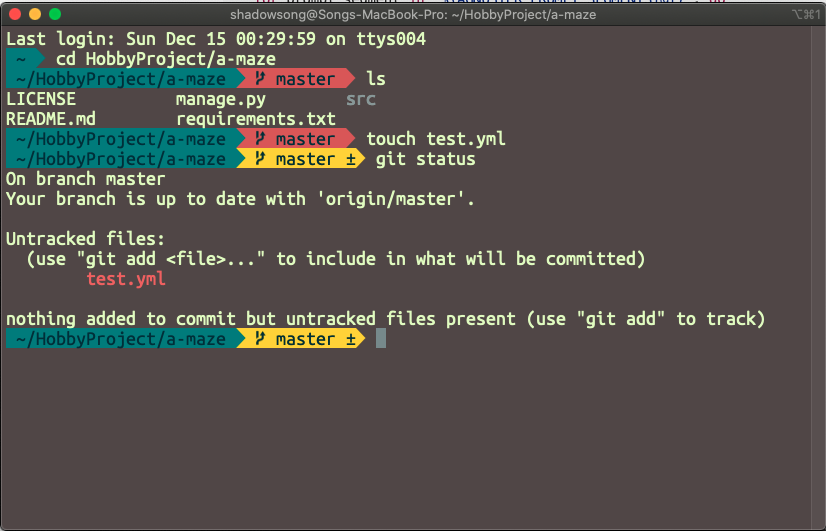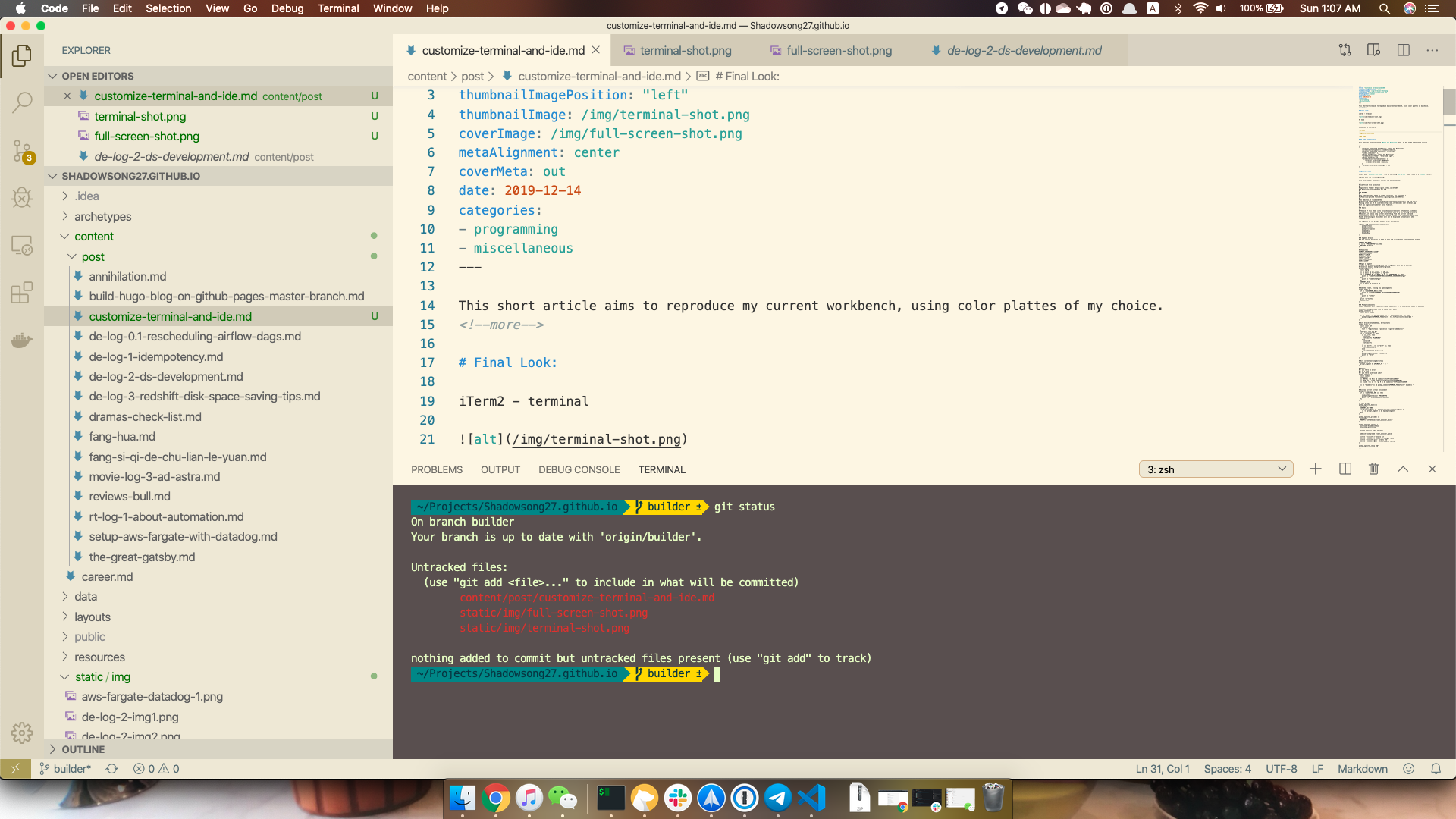Customize Terminal and IDE
This short article aims to reproduce my current workbench, using color plattes of my choice.
Final Look:
iTerm2 - terminal

VS Code

Resources to configure:
-
iTerm2
-
agnoster.zsh-theme
-
VS Code
VS Code Configuration
This requires installation of Menlo for Powerline font. It has to be a monospace version.
{
“terminal.integrated.fontFamily”: “Menlo for Powerline",
“workbench.startupEditor”: “newUntitledFile”,
"terminal.integrated.shell.osx": "/bin/zsh",
"window.zoomLevel": 1,
"editor.fontFamily": "Menlo for Powerline",
"workbench.colorTheme": "Solarized Light",
"editor.fontSize": 14,
"workbench.colorCustomizations": {
"terminal.background":"#594f4f",
"terminal.foreground":"#e5fcc2",
},
"terminal.integrated.lineHeight": 1.2
}
Agnoster Theme
Locate your agnoster.zsh-theme file by searching oh-my-zsh home. There is a themes folder.
Replace with the following config:
Note color number (256 color system) can be customized.
# vim:ft=zsh ts=2 sw=2 sts=2
#
# agnoster's Theme - https://gist.github.com/3712874
# A Powerline-inspired theme for ZSH
#
# # README
#
# In order for this theme to render correctly, you will need a
# [Powerline-patched font](https://gist.github.com/1595572).
#
# In addition, I recommend the
# [Solarized theme](https://github.com/altercation/solarized/) and, if you're
# using it on Mac OS X, [iTerm 2](http://www.iterm2.com/) over Terminal.app -
# it has significantly better color fidelity.
#
# # Goals
#
# The aim of this theme is to only show you *relevant* information. Like most
# prompts, it will only show git information when in a git working directory.
# However, it goes a step further: everything from the current user and
# hostname to whether the last call exited with an error to whether background
# jobs are running in this shell will all be displayed automatically when
# appropriate.
### Segments of the prompt, default order declaration
typeset -aHg AGNOSTER_PROMPT_SEGMENTS=(
prompt_status
prompt_context
prompt_virtualenv
prompt_dir
prompt_git
prompt_end
)
### Segment drawing
# A few utility functions to make it easy and re-usable to draw segmented prompts
CURRENT_BG='NONE'
if [[ -z "$PRIMARY_FG" ]]; then
PRIMARY_FG=black
fi
# Characters
SEGMENT_SEPARATOR="\ue0b0"
PLUSMINUS="\u00b1"
BRANCH="\ue0a0"
DETACHED="\u27a6"
CROSS="\u2718"
LIGHTNING="\u26a1"
GEAR="\u2699"
# Begin a segment
# Takes two arguments, background and foreground. Both can be omitted,
# rendering default background/foreground.
prompt_segment() {
local bg fg
[[ -n $1 ]] && bg="%K{$1}" || bg="%k"
[[ -n $2 ]] && fg="%F{$2}" || fg="%f"
if [[ $CURRENT_BG != 'NONE' && $1 != $CURRENT_BG ]]; then
print -n "%{$bg%F{$CURRENT_BG}%}$SEGMENT_SEPARATOR%{$fg%}"
else
print -n "%{$bg%}%{$fg%}"
fi
CURRENT_BG=$1
[[ -n $3 ]] && print -n $3
}
# End the prompt, closing any open segments
prompt_end() {
if [[ -n $CURRENT_BG ]]; then
print -n "%{%k%F{$CURRENT_BG}%}$SEGMENT_SEPARATOR"
else
print -n "%{%k%}"
fi
print -n "%{%f%}"
CURRENT_BG=''
}
### Prompt components
# Each component will draw itself, and hide itself if no information needs to be shown
# Context: user@hostname (who am I and where am I)
prompt_context() {
local user=`whoami`
if [[ "$user" != "$DEFAULT_USER" || -n "$SSH_CONNECTION" ]]; then
prompt_segment $PRIMARY_FG default " %(!.%{%F{yellow}%}.)$user@%m "
fi
}
# Git: branch/detached head, dirty status
prompt_git() {
local color ref
is_dirty() {
test -n "$(git status --porcelain --ignore-submodules)"
}
ref="$vcs_info_msg_0_"
if [[ -n "$ref" ]]; then
if is_dirty; then
color=220
ref="${ref} $PLUSMINUS"
else
color=167
ref="${ref} "
fi
if [[ "${ref/.../}" == "$ref" ]]; then
ref="$BRANCH $ref"
else
ref="$DETACHED ${ref/.../}"
fi
prompt_segment $color $PRIMARY_FG
print -n " $ref"
fi
}
# Dir: current working directory
prompt_dir() {
prompt_segment 30 $PRIMARY_FG ' %~ '
}
# Status:
# - was there an error
# - am I root
# - are there background jobs?
prompt_status() {
local symbols
symbols=()
[[ $RETVAL -ne 0 ]] && symbols+="%{%F{red}%}$CROSS"
[[ $UID -eq 0 ]] && symbols+="%{%F{yellow}%}$LIGHTNING"
[[ $(jobs -l | wc -l) -gt 0 ]] && symbols+="%{%F{cyan}%}$GEAR"
[[ -n "$symbols" ]] && prompt_segment $PRIMARY_FG default " $symbols "
}
# Display current virtual environment
prompt_virtualenv() {
if [[ -n $VIRTUAL_ENV ]]; then
color=cyan
prompt_segment $color $PRIMARY_FG
print -Pn " $(basename $VIRTUAL_ENV) "
fi
}
## Main prompt
prompt_agnoster_main() {
RETVAL=$?
CURRENT_BG='NONE'
for prompt_segment in "${AGNOSTER_PROMPT_SEGMENTS[@]}"; do
[[ -n $prompt_segment ]] && $prompt_segment
done
}
prompt_agnoster_precmd() {
vcs_info
PROMPT='%{%f%b%k%}$(prompt_agnoster_main) '
}
prompt_agnoster_setup() {
autoload -Uz add-zsh-hook
autoload -Uz vcs_info
prompt_opts=(cr subst percent)
add-zsh-hook precmd prompt_agnoster_precmd
zstyle ':vcs_info:*' enable git
zstyle ':vcs_info:*' check-for-changes false
zstyle ':vcs_info:git*' formats '%b'
zstyle ':vcs_info:git*' actionformats '%b (%a)'
}
prompt_agnoster_setup "$@"
iTerm2 Config
The rest of the color platte is controlled by iTerm2.
Using:
-
Foreground: #e5fcc2
-
Background: #594f4f
-
ANSI Red: #e96a67
ANSI Red was specifically changed because the original color looks too dark. Same rules should be applied to other ANSI colors if they are not obvious.